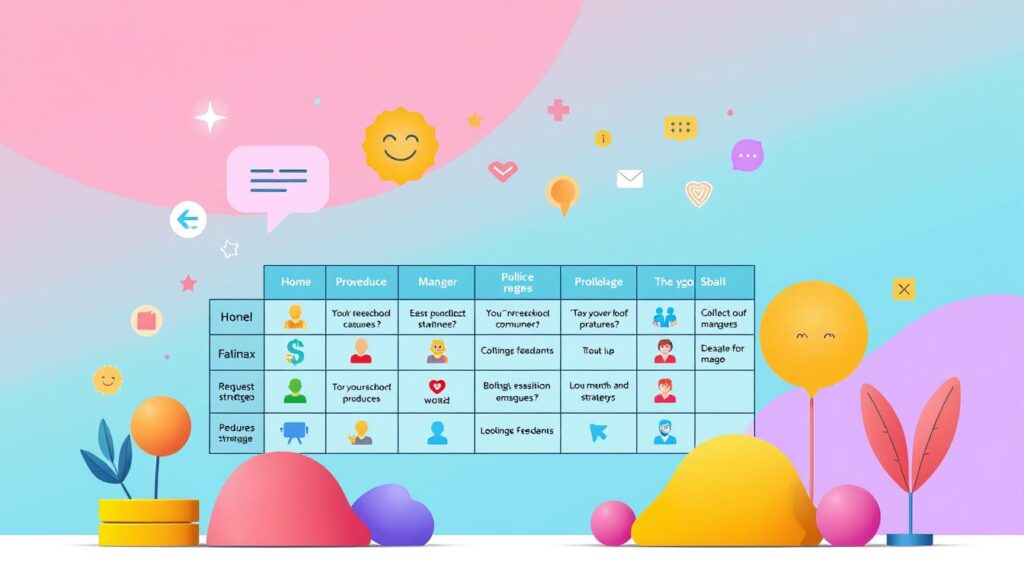Did you know over 65% of professionals say lack of feedback holds them back? Whether it’s in a work setting or just chatting, asking for feedback can make a big difference. Learning to ask for feedback in a way that encourages others to share their thoughts is key. It can improve how we interact and achieve better results.
So, how do you ask for feedback without saying “Please let me know what you think”? Let’s look at 15 different ways to ask for feedback that work in various situations. These methods can help us communicate more effectively and build stronger relationships.
The words you choose can greatly affect how others see your request. It also influences their willingness to respond. With these examples, you’ll see that asking for feedback can be done in many ways. Whether it’s through email, a team meeting, or a casual chat, there’s a right way to ask in every situation.
Before you ask for feedback next time, try one of these alternative ways. You’ll find that the conversation becomes more meaningful and engaging.
Key Takeaways
- Understanding that specific phrasing can increase the likelihood of receiving feedback.
- Recognizing the importance of tailoring your feedback request to the context of the conversation.
- Learning to use alternative expressions that can help others feel more comfortable to share their opinion.
- Enhancing professional and personal communication with a versatile feedback vocabulary.
- Illustrating each suggested expression with examples to ensure clarity and ease of use.
- Approaching feedback requests as an opportunity for meaningful engagement and growth.
Understanding the Importance of Feedback in Communication

Feedback is key in all areas of communication. It helps with personal and professional growth. It makes us better and strengthens our connections with others.
By seeking input, we learn from others. This is true in schools, work, and personal life. Good feedback turns arguments into chances for growth and teamwork.
Feedback is vital for better communication. It helps us hear and value everyone’s thoughts. This makes our talks more meaningful and productive.
Remember, what makes feedback truly valuable is not just the act of receiving it, but how you use it to foster growth and change.
Here are some key benefits of instilling a robust feedback culture:
- Improves Communication Skills: Feedback encourages clearer articulation of ideas and teaches us the importance of listening.
- Boosts Performance: Regular constructive feedback can lead to better results, as it helps individuals understand and align with the organizational goals.
- Enhances Learning and Development: Feedback acts as a direct catalyst for personal and professional growth, encouraging ongoing learning and adaptability.
- Strengthens Relationships: Open lines of communication build trust and mutual respect, crucial components for any successful relationship.
Embracing feedback changes how we talk to each other. It leads to deeper conversations and a culture of always getting better. Whether it’s through formal reviews or everyday chats, asking for feedback helps us grow and work well together.
Emphasizing the Value of a Person’s Opinion
In today’s workplace, everyone’s view can spark new ideas and help projects grow. By valuing different opinions, we make better decisions and achieve more success. Asking for opinions helps teams use their combined knowledge.
Why Your View Matters in Decision Making
When you share your thoughts, you help create a full picture of a situation. Good talks lead to smart choices, where all sides are considered. Your opinion is not just a contribution; it shapes the final result.
The Impact of Individual Insights on Overall Success
Every insight shared can make a big difference. In teams that value opinions, important details are less likely to be missed. Your voice helps improve your team’s work.

Here’s a table showing how often sharing opinions affects project success:
| Opinion-Sharing Frequency | Success Rate (%) |
|---|---|
| High | 85 |
| Moderate | 65 |
| Low | 45 |
This study shows teams that share opinions often do better. It proves that when everyone participates, the team succeeds together.
Related Guide:
15 Other Ways to Say “Wishing You the Best” (With Examples)
Polite Phrases for Requesting Feedback
In any professional setting, how you ask for feedback matters a lot. It can affect the quality of the feedback you get. Here are some polite ways to ask for feedback that keep the conversation positive and helpful. Use these phrases when you need feedback or want to know what others think.
- “I value your opinion, would you please let me know what you think about this?”
- “Could you take a moment to provide your feedback on this matter?”
- “I would appreciate your insights on this, could you please review it?”
- “Your perspective is important to me—could you share your thoughts on this?”
- “If you have a moment, I’d be grateful for your feedback on this.”
These phrases help set a respectful tone. This makes it more likely that your feedback request will be met positively.
Why Use Polite Phrases?
Using polite phrases is not just about being nice. It also affects the feedback you get. Being polite can lead to more detailed and thoughtful responses. When people feel respected, they’re more likely to give you honest and useful feedback.
Remember, the phrasing should fit the formality of your relationship and the context. Adjust it whether you’re emailing, having a face-to-face conversation, or in a formal meeting.
“Asking for feedback with respect reassures the recipient that their feedback is valued and taken seriously.”

Use these phrases to ask for feedback and create a positive atmosphere. Each phrase is an invitation, not a demand. This encourages honest and constructive dialogues. Remember, how you ask for feedback is key. See it as a chance for improvement and learning for everyone involved.
Finally, encourage others to use these polite phrases too. Building a culture of respectful and productive feedback can improve interactions and outcomes in your team or organization.
We hope these suggestions help. Let us know what you think. We’re always looking to improve based on your feedback.
Professional Expressions to Inquire for Thoughts
In work settings, how you ask for opinions matters a lot. Here are some polished ways and strategies to ask for thoughts well. They help start meaningful talks at work.
- “I value your expertise on this topic and would appreciate your input. Could you share your thoughts with me?”
- “As we aim to refine our strategy, your feedback could be very beneficial. What are your views on this approach?”
- “Considering your experience in this area, I would be interested to hear your perspective. Do you have any suggestions?”
These phrases show respect and clearly ask for feedback. They make it more likely to get helpful ideas back.
| Expression | Purpose | When to Use |
|---|---|---|
| “Could you help me understand your viewpoint on this?” | To politely ask for detailed explanations | When you need deeper insights into specific issues |
| “I’m reviewing some key areas and your input would be invaluable. What are your thoughts?” | To directly solicit advice on crucial matters | During critical decision-making phases |
| “Please let me know if you have any suggestions, I’m seeking input to enhance our current methods.” | To openly request improvements or changes | When looking to innovate or modify processes |
When you ask for input, it’s more than just getting info. It’s about creating a space where everyone feels free to share. This not only gets you great ideas but also makes your team stronger.
Remember, the secret to asking for thoughts well is to be clear, respectful, and open to different views. This leads to good and insightful talks. Use these phrases wisely to get useful feedback in any work conversation.
Creative Alternatives to “Please Let Me Know What You Think”
When we talk to others, we often say the same things. This can make our messages seem old. Here are some new ways to ask for opinions that make conversations better and more fun.
These phrases ask for feedback in a new way. They make people feel important and valued. This can lead to better feedback.
- “I value your insights on this, what are your thoughts?”
- “Could you point out ways to enhance this idea?”
- “Your expertise would be great here, can you provide some feedback?”
- “I’m looking to improve this concept—might you help me refine it?”
- “Your input would be beneficial; what do you suggest we change?”
When we ask for opinions, we want to get good feedback. Using these creative phrases helps. They make people want to help and share their ideas.
| Traditional Request | Creative Alternative | Added Value |
|---|---|---|
| “Let me know what you think.” | “Your unique perspective on this would be enlightening.” | Highlights the uniqueness of the individual’s viewpoint. |
| “Please give me your feedback.” | “How could we perfect this together?” | Emphasizes teamwork and joint development. |
| “Any suggestions?” | “How could we innovate this concept?” | Encourages creative and forward-thinking ideas. |
These creative ways to ask for opinions make people feel special. They are more likely to give good feedback. Try them out next time you ask for feedback. You’ll get better ideas and grow together.
Encouraging Open Dialogue and Shared Opinions
In today’s work world, open dialogue is key. It’s about sharing different views to get a full picture. By asking for opinions and listening, we create a space for growth and new ideas.
Fostering a Collaborative Environment
A place where feedback is welcomed is essential. It makes a team smarter and more adaptable. This way, solving problems and learning together becomes easier.
Inviting Varied Perspectives for Enriched Conversations
Different ideas are a treasure. When everyone shares, we find new and creative solutions. By listening to all, we build a positive and inclusive team.
- Regularly schedule brainstorming sessions that encourage uninhibited thought sharing.
- Use open-ended questions to provoke deeper thinking and detailed responses.
- Make transparency a priority in all communications, ensuring that every voice is heard and valued.
The goal is to get as many views as possible. This makes our discussions richer and our decisions better.
| Strategy | Benefits | Implementation Tip |
|---|---|---|
| Open Forums | Increases transparency, builds trust | Schedule regular meetings with no preset agenda |
| Feedback Channels | Encourages continuous improvement | Implement anonymous digital suggestion boxes |
| Diverse Teams | Enhances creativity and innovation | Ensure representation from different departments and backgrounds |
These methods improve how we talk and work together. They make everyone feel valued and help us reach our goals together.
Casual Ways to Ask for Someone’s Perspective
In a relaxed setting, how you ask for feedback matters a lot. It can change the kind of answers you get. Here are some easy yet effective ways to ask for opinions without being too formal.
- “What’s your take on this?”
- “I’d love your thoughts on this, whenever you have a moment.”
- “Got a sec? I’d appreciate your feedback on something.”
- “How do you feel about this idea?”
- “What would you do differently if this were up to you?”
Being informal makes it easier for people to share more. This can make your feedback request better.
Using these casual phrases can make sharing ideas more enjoyable. Whether it’s over coffee or a quick break, they help start honest talks.
Also, always show you care about the feedback you get. Saying thanks to everyone’s input builds better relationships. It also keeps the conversation going.
“Asking for feedback doesn’t have to be formal. Relax, be yourself, and just ask.”
Tactful Lines to Seek Valuable Input
Looking for ways to ask for feedback can really improve the quality of what you get. Being tactful helps create a space for honest and helpful feedback. Let’s explore how to mix tact with directness in your requests.
Showing Appreciation for Honest Insights
It’s key to thank someone for their feedback. A simple “thank you” can make them more likely to share more. Showing gratitude makes the conversation respectful and engaging.
Balancing Tactfulness with Directness in Feedback Requests
Being polite is important, but clarity is key. Ask clearly what you want, and be nice about it. This makes it easier for others to give you good feedback.
In both work and personal life, here are some ways to ask for feedback:
- “I value your insight on this matter. Could you share your thoughts on how we can improve?”
- “Your experience is particularly relevant here. I would appreciate your detailed feedback on my recent presentation.”
- “As someone who understands this topic well, your honest opinion would be incredibly valuable to me.”
Using these methods shows you value the person’s opinion and want real feedback. This leads to more meaningful conversations.
| Feedback Style | Response Rate | Quality of Feedback |
|---|---|---|
| Direct | 50% | Moderate |
| Tactful | 75% | High |
In summary, mixing tact and directness in your feedback requests boosts both the amount and quality of feedback. This approach helps you make better decisions and build stronger relationships.
Email Templates to Request Feedback
Writing a good email to ask for feedback can really help. Make sure to explain why you need it and thank the person for their time. This makes the feedback more useful and positive.
Email is a great way to get feedback from anyone. Here are three templates to help you ask for feedback well.
| Scenario | Email Template |
|---|---|
| Project Feedback | Subject: Request for Project Feedback Dear [Recipient’s Name], I hope you’re doing well. I’m working on our project and want your thoughts to make it better. Your opinion is really important to us. Thanks for your help, [Your Name] |
| Product Review | Subject: Your Thoughts on Our New Product Hello [Recipient’s Name], We just launched a new product and want to hear what you think. Your feedback helps us make sure we meet your needs and provide great experiences. Looking forward to your thoughts, [Your Name] |
| Service Enhancement | Subject: Your Feedback Can Help Us Improve! Hi [Recipient’s Name], We’re always trying to get better, and your opinion matters a lot. Please share what you think about our services and how we can improve. Thanks for your input! [Your Name] |
Each template aims to show you need their help and value their opinion. Adding personal touches can make the email more engaging. This leads to more detailed and helpful feedback.
Adapting Your Language for Different Audiences
How you ask for feedback can really affect the answers you get. It’s key to adjust your words for the audience you’re talking to. Whether it’s work or a casual chat, choose words that connect with your listeners.
Understanding the Tone Suited for Professional Contexts
In work settings, speak with respect and formality. Casual phrases might seem unprofessional. Clear and polite language leads to better outcomes when asking for opinions.
Choosing the Right Words for Informal Discussions
With friends or family, the tone is more relaxed. It’s about building a friendly atmosphere for open talks. To get people to share their thoughts, use a warmer, friendlier tone.
| Context | Recommended Approach | Sample Phrases |
|---|---|---|
| Professional | Formal, Direct | “I would value your feedback on this.” |
| Semi-formal | Polite, Engaging | “Could you take a moment to review this?” |
| Informal | Conversational, Friendly | “Let me know what you think about this!” |
Changing your approach based on the situation can lead to better feedback. Always think about your audience and the setting before asking for input. This way, you’re more likely to have meaningful conversations.
How to Respond Constructively to Feedback
When you get feedback, how you respond matters a lot. It can shape how you communicate and grow. Whether it’s about wanting to improve, sharing thoughts on a project, or answering an opinion question, here’s how to do it well.
Listening is key. Listen carefully to what the feedback giver says without interrupting. This shows you value their thoughts and helps you understand their point better.
- Thank the person for their feedback, no matter what.
- Ask questions if you’re not sure about something.
- Make sure you get what they said right by summarizing.
Once you’ve thought it over, write a response that shows you’ve put some thought into it. Here are some phrases that show you’re open to feedback:
- “I appreciate your insights and will look into addressing these issues.”
- “Your feedback is valuable, and I will develop a plan to implement changes.”
- “Can we discuss this further to explore potential solutions?”
Being good at feedback means not just reacting but also working with the person who gave it. This creates a space where feedback helps you grow.
Your aim is to engage with the feedback. Make it a part of how you get better. Being open to feedback, valuing opinions, and asking questions shows you’re committed to learning and improving.
Conclusion
Exploring how to ask for feedback has shown its importance in improving communication. Whether it’s in a work setting or with friends, the right words matter a lot. Asking for opinions shows respect and opens the door for better interactions.
Every situation calls for a different way to ask for feedback. The phrases you choose should match your audience and the conversation’s context. This shows you care about clear communication and value different kinds of interactions.
Learning to ask for feedback with care and accuracy is key. It helps create a culture where everyone feels heard. Remember, how you ask for feedback is just as important as the feedback itself. Use these tips to improve your communication skills and strengthen your relationships.
FAQ
What are some other ways to say “Please let me know what you think”?
You can say “I’d appreciate your feedback,” or “Feel free to share your thoughts.” You could also say “I welcome your insights on this matter.”
Why is feedback important in communication?
Feedback helps us grow and improve. It makes communication better. It helps us understand each other better and make smarter choices.
How does sharing your opinion impact decision making?
Sharing your opinion adds unique insights. It helps consider different views. This leads to better decisions and more options.
Can you give examples of polite phrases for requesting feedback?
Sure. You can say “Your feedback would be greatly valued,” or “I’d love to hear your thoughts on this.” You could also say “Your perspective on this would be greatly beneficial.”
What are professional expressions to inquire for thoughts?
In work settings, say “I value your input on this subject.” Or “Please provide your insights at your earliest convenience.” You could also say “Your expertise on this topic would be highly appreciated.”
Are there creative alternatives to asking for feedback?
Yes. You can say “Lend me your thoughts on this,” or “I’m eager to hear your creative take.” You might also say “I’m interested in your unique viewpoint on this challenge.”
How do you encourage open dialogue and shared opinions?
Create a space where everyone feels heard and valued. Say “This is a safe space for all ideas,” or “Let’s pool our thoughts to find the best solution.”
What are some casual ways to ask for someone’s perspective?
You can say “What’s your take on this?” or “I’d love your two cents.” This makes people feel comfortable and more likely to share.
Can you provide tactful lines to seek valuable input?
Sure. Say “I really respect your opinion and would love your honest input,” or “Your insights would be very helpful to me.”
What should email templates to request feedback include?
Email templates should be short and polite. Clearly ask for feedback and thank the recipient. Tailor it to the context and the person.
How do you adapt your language for different audiences when asking for feedback?
Adjust your tone based on the situation and who you’re talking to. Be formal and respectful in work settings. Use a friendly tone for personal conversations.
How should you respond to feedback?
Thank the person for their feedback. Show you value their input. Be open to discussing it and willing to make changes.

As a content writer with five years of experience, I focus on creating insightful and impactful website content that drives engagement and boosts search visibility. With a strong foundation in SEO and digital marketing, I excel at crafting compelling narratives that resonate with audiences and enhance brand storytelling. My passion for data-driven content creation allows me to deliver pieces that not only inform but also inspire action. Whether through blog posts, web copy, or informative articles, I strive to empower businesses to connect authentically with their customers.







